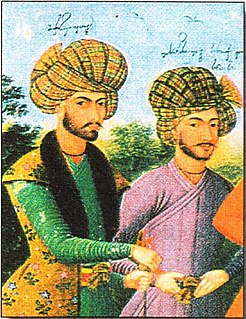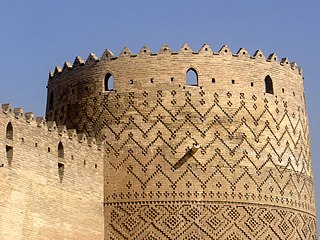
Tahmasp I was the second Shah of Safavid Iran from 1524 to 1576. He was the eldest son of Ismail I with his principal consort, Tajlu Khanum.

The Battle of Karnal, was a decisive victory for Nader Shah, the founder of the Afsharid dynasty of Iran, during his invasion of India. Nader's forces defeated the army of Muhammad Shah within three hours, paving the way for the Iranian sack of Delhi. The engagement is considered the crowning jewel in Nader's military career as well as a tactical masterpiece. The battle took place near Karnal, 110 kilometres (68 mi) north of Delhi, India.

Tahmasp II (1704? – 11 February 1740) was one of the last Safavid rulers of Persia (Iran).

The Afsharid dynasty was an Iranian dynasty that originated from the Turkoman Afshar tribe in Iran's north-eastern province of Khorasan, ruling Iran (Persia) in the mid-eighteenth century. The dynasty was founded in 1736 by the brilliant military commander Nader Shah, who deposed the last member of the Safavid dynasty and proclaimed himself as the Shah of Iran.

The Battle of Damghan or Battle of Mehmandoost was fought on September 29 to October 5, 1729, near the city of Damghan. It resulted in an overwhelming victory for Nader and the Safavid cause he had taken up, though by itself it did not end Ashraf's rule in Iran, it was a significant triumph which led to further successes in the following engagements of the campaign to restore Tahmasp II to the throne. The battle was followed by another one in Murcheh-Khort, a village near Isfahan. Nader's forces were victorious in both battles, which led him to remove the Ghilzai Afghan dynasty from their short stay on the Persian throne. The Hotakis were forced back to their territory in what is now southern Afghanistan.

Nader Shah Afshar was the founder of the Afsharid dynasty of Iran and one of the most powerful rulers in Iranian history, ruling as shah of Iran (Persia) from 1736 to 1747, when he was assassinated during a rebellion. He fought numerous campaigns throughout the Middle East, the Caucasus, Central and South Asia, such as the battles of Herat, Mihmandust, Murche-Khort, Agh-Darband, Yeghevard, Khyber Pass, Karnal and Kars. Because of his military genius, some historians have described him as the Napoleon of Persia, the Sword of Persia, or the Second Alexander. Nader belonged to the Turkoman Afshar tribe, a semi-nomadic tribe settled in Khorasan in northeastern Iran, which had supplied military power to the Safavid dynasty since the time of Shah Ismail I.

Givi Amilakhvari (1689–1754) was a Georgian nobleman (tavadi) with a prominent role in the politics of eastern Georgia in the first half of the 18th century. He waged a lengthy struggle against the Ottoman and Iranian encroachments, changing sides and forging various alliances as he tried to preserve autonomy for his native kingdom of Kartli as well as to prevent the ascendant Bagrationi dynasty of the neighboring Georgian kingdom of Kakheti from seizing the throne of Kartli. In the closing years of his turbulent life, Amilakhvari stood by his erstwhile Kakhetian foes and sponsored several construction projects across the country.

The Ottoman–Persian War was a conflict between the forces of the Safavid Empire and those of the Ottoman Empire from 1730 to 1735. After Ottoman support had failed to keep the Ghilzai Afghan invaders on the Persian throne, the Ottoman possessions in western Persia, which were granted to them by the Hotaki dynasty, came under risk of re-incorporation into the newly resurgent Persian Empire. The talented Safavid general, Nader, gave the Ottomans an ultimatum to withdraw, which the Ottomans chose to ignore. A series of campaigns followed, with each side gaining the upper hand in a succession of tumultuous events that spanned half a decade. Finally, the Persian victory at Yeghevard made the Ottomans sue for peace and recognize Persian territorial integrity and Persian hegemony over the Caucasus.

The campaigns of Nader Shah, or the Naderian Wars, were a series of conflicts fought in the early to mid-eighteenth century throughout Central Eurasia primarily by the Iranian conqueror Nader Shah. His campaigns originated from the overthrow of the Iranian Safavid dynasty by the Hotaki Afghans. In the ensuing collapse and fragmentation of the empire after the capture of the Iranian capital of Isfahan by the Afghans, a claimant to the Safavid throne, Tahmasp II, accepted Nader into his service. After having subdued north-west Iran as well as neutralising the Abdali Afghans to the east as well as turning Tahmasp II into a vassal, Nader marched against the Hotaki Afghans in occupation of the rest of the country. In a series of incredible victories the Afghans were decimated and Tahmasp II returned to the throne as a restored Safavid monarch.
The Battle of Sangan was an engagement involving the Loyalist forces of Tahmasp II of Safavid Iran led by Nader and the Abdali Afghan Tribes in and further beyond southern Khorasan in the autumn of 1727. This armed struggle was one of the initial battles between the resurgent Safavid cause and that of the Afghans. The engagement technically ended in a Safavid victory.

The Sabzevar expedition was a politically decisive event in Nader's career where he in effect turned from mere commander-in-chief of Tahmasp's forces into the real power behind the throne. The expedition was launched mainly due to Tahmasp's own incompetence and ill-thought attempt at curbing the powers of his upstart general and military genius.

The Battle of Murche-Khort was the last decisive engagement of Nader's campaign to restore Tahmasp II to the Persian throne. Ashraf Hotak had failed to arrest Nader's advance onto Isfahan at Khwar pass where his ambush was discovered, surrounded and ambushed itself. The battle was fought in an uncharacteristic manner by the Afghans who to some extent sought to replicate their foes tactical systems which had so badly devastated their armies up to this point. Victory opened a clear road south towards Isfahan and the return of Safavid rule for a few brief years before Nader himself would overthrow it.

Nader's Western Persia campaign of 1730 was his first against perhaps his most formidable of adversaries, namely the Ottomans, where he proved triumphant in conquest. The great successes of his expedition, however, were rendered null when Shah Tahmasp II decided to take personal command of the theatre in Nader's absence, forcing a furious Nader to return and rectify the situation after forcing Tahmasp's abdication in favour of his infant son Abbas III.

The campaign of 1731 was a failed attempt by Tahmasp II of the Safavid dynasty to launch an offensive into Ottoman held Caucasus which ended in a disastrous defeat with all of Nader's gains during the previous year being lost. The result of this particular military catastrophe was still overturned with Nader's return from the east but would have much more significant impact on the Safavid dynasty itself as Tahmasp II sealed his own fate by initiating this ill fated expedition.

In the aftermath of Nader's crippling defeat and expulsion from Ottoman Baghdad the commander who was put in charge of the 12,000 soldiers to maintain the siege of the city, Mohammad Khan Baluch, fled from Mesopotamia and returned to southern Persia where taking advantage of Nader's shattered prestige due to his ignominious defeat at the hands of Topal Pasha at the Battle of Samarra, Mohammad Khan raised the banner of rebellion in the south of the country. He also allied with Sheikh Ahmad Madani's Revolt.

Reza Qoli Mirza Afshar (1719–1749) was the first son of the Afsharid conqueror Nader Shah. When Nader came under the service of a Persian nobleman who hired him as a courier, Nader killed his assistant courier. Though his speech to the Persian king Sultan Husayn convinced the king to pardon him, when Nader returned to his employer the nobleman was angered and Nader suspected he would try and kill him. To make it worse Nader had fallen in love with the nobleman's daughter and wished to marry her. When the nobleman refused the marriage proposal, Nader killed him and ran off with his daughter into the mountains where Reza Qoli Mirza was born. Reza, being the only child from Nader's first marriage, held a special status amongst the Shah's sons and was given the title of viceroy when Nader left Persia on a military expedition to Mughal India. He proved himself a competent commander who side by side with Nader's veteran lieutenant Tahmasp Khan Jalayer, defeated the Uzbek armies to the east of the empire although Nader ordered a halt to hostilities.
Hasan-Ali Beg Bestami was an important Safavid official, who subsequently became one of the closest associates of Nader Shah, serving as his chief assayer.
Ali Mardan Khan Bakhtiari was the Bakhtiari supreme chieftain (ilkhani) of the Chahar Lang branch, and major contender for supremacy in western Iran after the death of Nader Shah in 1747.
Hossein Qoli Khan Qajar was the Qajar chieftain of the Qoyunlu branch from 1759 till his death in 1777.
The Rebellion of Sheikh Ahmad Madani was a revolt in the Garmsirat region of Iran from January 1730 as the Hotaks were being pushed out of Iran up until May 1734 when Sheikh Ahmad Madani was captured., although the rebellion continued until the middle of June 1734 before it was finally crushed.














